How to Secure a Guinea Pig Carrier in Your Vehicle
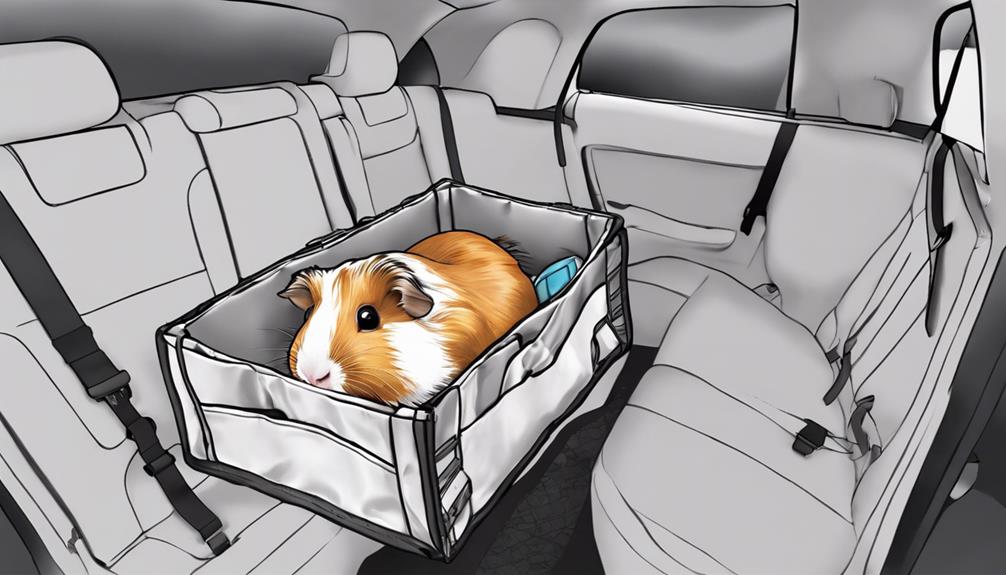
Securing a guinea pig carrier in your vehicle is essential to ensure your pet's safety during travel. Here are some key strategies to follow:
- Choose a sturdy carrier specifically designed for guinea pigs. Make sure it has proper ventilation and secure closures to prevent escapes.
- Place the carrier in a secure spot in your vehicle, such as on the floor behind the front seats or in the cargo area of an SUV. Avoid placing it on a seat, as it could move around during the drive.
- Use a seatbelt or straps to secure the carrier in place. This will prevent it from shifting or tipping over if you need to brake suddenly.
- Cover the carrier with a light blanket or towel to help keep your guinea pig calm during the ride. Avoid covering it completely to ensure proper airflow.
- Avoid sudden stops and sharp turns while driving to prevent the carrier from sliding or tipping over. Drive carefully to provide a smooth and stress-free ride for your pet.
By following these strategies, you can ensure that your guinea pig stays safe and secure during car rides. Remember to check on your pet regularly and provide water and food if the journey is long. Your guinea pig will thank you for taking the necessary precautions to keep them safe on the road.
Key Takeaways
- Choose a sturdy carrier with secure closures and use seatbelt or straps for stability.
- Position carriers strategically for ventilation, away from airbags, and on flat surfaces.
- Drive carefully to prevent carrier movement, avoiding sudden stops and sharp turns.
- Monitor guinea pigs during travel, checking for distress, food, water intake, and overall comfort.
Importance of Securing the Carrier
Securing the carrier properly is paramount when transporting your guinea pig in a vehicle to guarantee their safety and well-being. Carrier stability is critical to prevent any unexpected movements that may startle or harm your furry companion. Before starting on the journey, make sure that the carrier is securely positioned in the vehicle. Placing it on a flat surface and using seat belts to fasten it in place can greatly enhance the stability of the carrier.
To further enhance safety precautions, consider placing a non-slip mat underneath the carrier to prevent any sliding during turns or sudden stops. Additionally, avoid stacking heavy items on or around the carrier to maintain its stability. By taking these simple yet effective measures, you can create a secure environment for your guinea pig while traveling.
Choosing the Right Location
Positioning the guinea pig carrier in the vehicle requires careful consideration of the surroundings to guarantee maximum safety for your furry companion. When choosing the right location, prioritize carrier stability and vehicle safety.
Here are five essential tips to help you secure the carrier effectively:
- Avoid placing the carrier on the front seat: In the event of a sudden stop or impact, the front seat is risky for your guinea pig.
- Guarantee the carrier on a flat surface: Make sure the carrier sits securely on a stable surface to prevent it from sliding or tipping over during the journey.
- Keep the carrier away from airbags: Placing the carrier near airbags can pose a danger to your guinea pig in case of deployment.
- Provide proper ventilation: Make sure there's adequate airflow around the carrier to keep your pet comfortable and prevent overheating.
- Consider the noise level: Select a location in the vehicle that minimizes noise and vibrations, creating a calmer environment for your guinea pig.
Utilizing Seat Belts or Straps
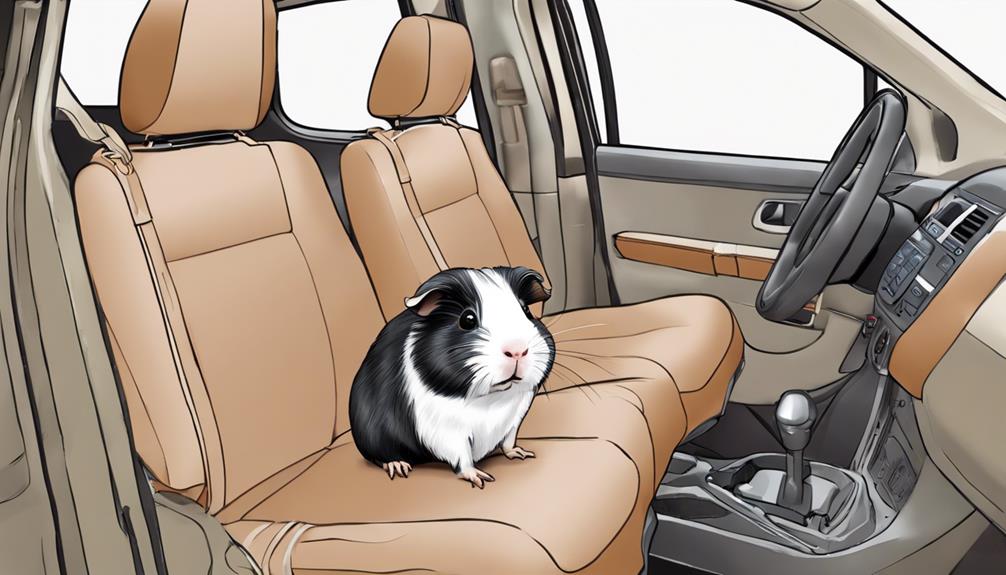
For best safety and stability during travel with your guinea pig, consider fastening the carrier securely using seat belts or straps. Safety measures are vital when transporting your small pet in a vehicle. Proper restraint is key to ensuring your guinea pig's well-being during the journey. By utilizing seat belts or straps, you can prevent the carrier from shifting or moving around unexpectedly, reducing the risk of accidents or injuries to your furry companion.
When securing the carrier with seat belts, make sure to thread the belt through the carrier's handle or around its base, depending on the design. Tighten the seat belt to keep the carrier in place without being too restrictive. If using straps, attach them securely to the carrier's designated anchor points, if available, or around the carrier itself. Double-check that the carrier is stable and unable to tip over or slide around while driving.
Preventing Sliding and Tipping
To prevent any sliding or tipping of the guinea pig carrier while in transit, guarantee a stable and secure placement within the vehicle. Utilize anti-slip mats to provide traction and prevent the carrier from shifting around. Secure the carrier with stabilizing straps to hold it in place during sudden stops or turns.
Make sure the safety of your furry friend by using safety harnesses to keep them secure inside the carrier. Double-check that the carrier is equipped with secure latches that won't accidentally open while driving.
Ensuring Proper Ventilation
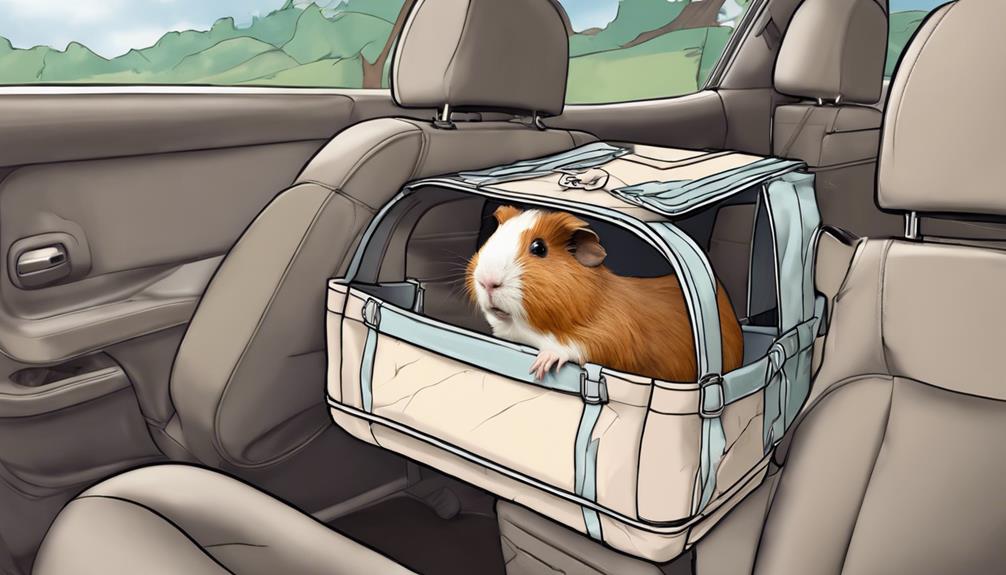
Proper ventilation is indispensable to guarantee the comfort and well-being of your guinea pig during travel. Ensuring a good airflow within the carrier is essential to prevent overheating or suffocation. When setting up the carrier for your furry friend, consider the placement of ventilation holes. Strategically positioning these openings around the carrier will promote proper air circulation and keep your guinea pig cool and content throughout the journey.
To further enhance ventilation and airflow management, select a carrier specifically designed with ventilation in mind. Look for carriers with mesh panels or sides that allow for adequate airflow while keeping your pet secure. However, always prioritize safety precautions when choosing a carrier with openings to make sure your guinea pig cannot escape or get injured.
| Ventilation Placement | Safety Precautions | Airflow Management | Carrier Design |
|---|---|---|---|
| Strategically position ventilation holes for optimal airflow | Make sure openings are secure to prevent escapes or injuries | Choose carriers with mesh panels for proper ventilation | Select carriers designed with ventilation in mind |
Monitoring Temperature and Sunlight
Ensuring your guinea pig's comfort and safety during travel also involves closely monitoring the temperature and sunlight exposure within the carrier. Here are some essential tips to keep in mind:
- Sunlight Exposure: Place the carrier away from direct sunlight to prevent overheating.
- Temperature Monitoring: Use a thermometer inside the carrier to make sure it stays within the safe temperature range for guinea pigs.
- Air Circulation: Guarantee proper ventilation by opening windows slightly or using a carrier with ventilation holes.
- Safety Precautions: Avoid placing the carrier near heating vents or air conditioning units that could create temperature extremes.
- Emergency Supplies: Keep a small cooler with ice packs in case the temperature rises unexpectedly.
Handling Stops and Turns Safely
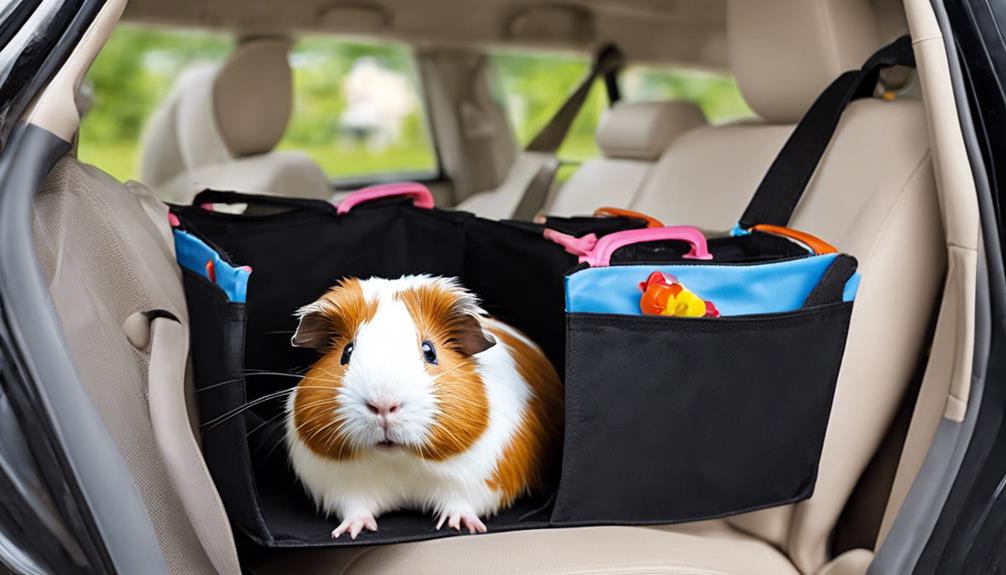
When transporting a guinea pig in your vehicle, it's essential to secure the carrier properly during turns to prevent it from shifting.
Ensuring that stops are smooth can help prevent sudden movements that may startle your furry passenger.
Secure Carrier During Turns
Securing your guinea pig carrier firmly during turns is crucial to guarantee the safety and comfort of your furry passenger. To accomplish this, consider the following tips:
- Distribute Weight Evenly: Balance the carrier's weight to prevent tipping.
- Use Seatbelts: Secure the carrier with seatbelts or straps for additional stability.
- Avoid Sharp Turns: Slow down before making sharp turns to prevent sliding.
- Position Carrier Low: Place the carrier on the vehicle's floor for better stability.
- Check Carrier Position: Make sure the carrier is securely placed and won't shift during turns.
Ensure Stops Are Smooth
Positioning the carrier securely during stops is as important as securing it during turns for the safety and comfort of your guinea pig. Ensuring smooth stops is vital to maintaining carrier stability and preventing your furry friend from getting jostled around.
When coming to a stop, gently apply the brakes to avoid sudden jerks that could cause the carrier to shift. Anticipating stops and decelerating gradually will help keep the carrier in place and your guinea pig content. Smooth stops not only contribute to your pet's well-being but also make the journey more pleasant for both of you.
Prevent Carrier Movement
To guarantee a safe and smooth journey for your guinea pig, it's essential to prevent any movement of the carrier by handling stops and turns safely. Ensuring carrier stability is vital in preventing accidents and maintaining travel comfort for your furry companion. Here are some safety precautions to help you handle stops and turns securely:
- Secure the carrier with a seatbelt or other restraints.
- Place the carrier on a flat surface to avoid tipping.
- Drive cautiously, especially around corners and when braking.
- Avoid sudden movements that could jostle the carrier.
- Consider using non-slip padding inside the carrier to prevent sliding.
Checking on Your Guinea Pig Regularly
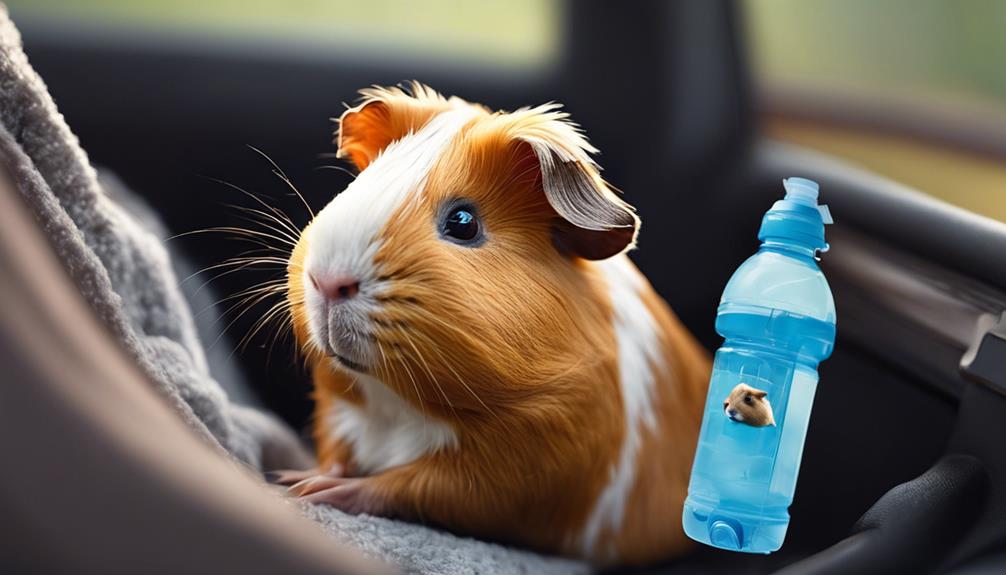
As you set off on a journey with your furry companion in tow, remember the importance of checking on your guinea pig regularly.
Keep a watchful eye on your guinea pig with regular visual checks, ensuring their comfort and safety throughout the trip.
Monitoring food and water intake, as well as ensuring proper ventilation, are key practices to maintain their well-being while traveling.
Regular Visual Checks
Regularly observe your guinea pig during transport to guarantee their comfort and well-being throughout the journey. It's important to make sure they're safe and content while on the move. Here are some essential visual checks to perform:
- Check for signs of distress: Look out for any unusual behavior or sounds that might indicate your guinea pig is uncomfortable.
- Monitor for spills or mess: Keep an eye on the carrier to confirm your pet isn't sitting in any spills or waste.
- Inspect carrier ventilation: Make sure there's enough airflow for your guinea pig to breathe comfortably.
- Ensure carrier stability: Verify that the carrier is secure and stable to prevent any accidents during the journey.
- Observe for any signs of illness: Watch for any symptoms of sickness or discomfort in your guinea pig.
Monitor Food and Water
Keeping a close eye on your guinea pig's food and water intake is vital to ensuring their well-being and comfort during transport. Hydration monitoring is essential, especially during travel stress, to prevent dehydration. Make sure your guinea pig has access to fresh water at all times, and consider offering water more frequently than usual. Additionally, food rationing may be necessary to prevent upset stomachs during the journey.
Keep an eye on their water intake, as stress can cause changes in their drinking habits. By monitoring their food and water consumption closely, you can guarantee that your guinea pig stays healthy and comfortable throughout the trip. Remember, a well-fed and hydrated guinea pig is a happy and contented traveler.
Ensure Proper Ventilation
Ensuring proper ventilation for your guinea pig carrier is essential for their comfort and well-being during travel. It's critical to maintain a suitable environment inside the carrier to keep your pet safe and happy. Here are some tips to guarantee proper ventilation:
- Monitor Temperature Control: Guarantee the carrier isn't too hot or cold.
- Promote Air Circulation: Place the carrier in a well-ventilated area of the vehicle.
- Check Carrier Security: Guarantee the carrier is securely fastened to prevent any accidents.
- Guarantee Pet Comfort: Place familiar bedding and toys to keep your guinea pig at ease.
- Regularly Check on Your Guinea Pig: Monitor your pet's behavior and well-being throughout the journey.
Frequently Asked Questions
Can I Use a Regular Pet Carrier for My Guinea Pig in the Car, or Do I Need a Specific Guinea Pig Carrier?
When deciding on a carrier for a guinea pig in the car, it is crucial to prioritize their safety. Opt for a carrier specifically designed for guinea pigs to guarantee proper ventilation, security, and comfort during travel.
Are There Any Specific Laws or Regulations Regarding Transporting Guinea Pigs in Vehicles?
When transporting guinea pigs in vehicles, it is important to guarantee compliance with regulations for their safety. Using appropriate carriers compatible with your vehicle is vital. Always prioritize the comfort and security of your furry passengers.
How Can I Ensure My Guinea Pig Stays Calm and Comfortable During Car Rides?
To guarantee a guinea pig stays calm and comfortable during car rides, utilize calming techniques like soft music or covering the carrier with a blanket. Implement comfort measures such as placing familiar bedding inside. Safety precautions and gentle handling tips are essential for a stress-free journey.
What Should I Do if My Guinea Pig Becomes Sick or Stressed During a Car Journey?
When a guinea pig becomes sick or stressed during a car journey, it's important to handle motion sickness and provide comfort items and distractions. Staying calm and offering gentle reassurance can help alleviate their discomfort and anxiety.
Are There Any Special Precautions I Should Take if I Have More Than One Guinea Pig in the Carrier?
When handling multiple guinea pigs in a carrier, it's essential to make sure the carrier size allows ample space for each pig to move comfortably. Providing separate hiding spots and securing the carrier properly can help minimize stress during travel.











